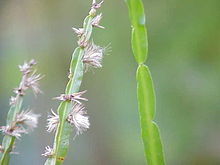Baccharis genistelloides: Difference between revisions
Appearance
Content deleted Content added
Tone; + taxonbar from=Q15589375 |
No edit summary |
||
| Line 5: | Line 5: | ||
}} |
}} |
||
'''''Baccharis genistelloides''''' (also called '''''Baccharis trimera''''' or '''carqueja'''<ref name=":0">{{Cite book|last=Riet-Correa|first=Franklin|url=https://books.google.com/books?id=DmLQ2NuPbBIC&newbks=0&printsec=frontcover&pg=PA713&dq=Baccharis+trimera&hl=en|title=Poisoning by Plants, Mycotoxins, and Related Toxins|date=2011|publisher=CABI|isbn=978-1-84593-833-8|pages=713|language=en}}</ref>) is a [[species]] of plant from the family [[Asteraceae]].<ref name=":1" /> ''B. genistelloides'' is one of the most studied species in the genus [[Baccharis]] regarding its [[phytochemistry]] and [[Pharmacology|pharmacological]] effects.<ref>{{Cite book|last=Máthé|first=Ákos|url=https://books.google.com/books?id=3sYpEAAAQBAJ&pg=PA104&dq=Baccharis+trimera&hl=en&newbks=1&newbks_redir=0&source=gb_mobile_search&sa=X&ved=2ahUKEwiPp__CnvLyAhWRElkFHXeuBCoQ6AF6BAgHEAM|title=Medicinal and Aromatic Plants of South America Vol. 2: Argentina, Chile and Uruguay|last2=Bandoni|first2=Arnaldo|date=2021-04-15|publisher=Springer Nature|isbn=978-3-030-62818-5|pages=88|language=en}}</ref> |
'''''Baccharis genistelloides''''' (also called '''''Baccharis trimera''''' or '''carqueja'''<ref name=":0">{{Cite book|last=Riet-Correa|first=Franklin|url=https://books.google.com/books?id=DmLQ2NuPbBIC&newbks=0&printsec=frontcover&pg=PA713&dq=Baccharis+trimera&hl=en|title=Poisoning by Plants, Mycotoxins, and Related Toxins|date=2011|publisher=CABI|isbn=978-1-84593-833-8|pages=713|language=en}}</ref>) is a [[species]] of plant from the family [[Asteraceae]].<ref name=":1" /> ''B. genistelloides'' is one of the most studied species in the genus [[Baccharis]] regarding its [[phytochemistry]] and [[Pharmacology|pharmacological]] effects.<ref>{{Cite book|last=Máthé|first=Ákos|url=https://books.google.com/books?id=3sYpEAAAQBAJ&pg=PA104&dq=Baccharis+trimera&hl=en&newbks=1&newbks_redir=0&source=gb_mobile_search&sa=X&ved=2ahUKEwiPp__CnvLyAhWRElkFHXeuBCoQ6AF6BAgHEAM|title=Medicinal and Aromatic Plants of South America Vol. 2: Argentina, Chile and Uruguay|last2=Bandoni|first2=Arnaldo|date=2021-04-15|publisher=Springer Nature|isbn=978-3-030-62818-5|pages=88|language=en}}</ref> The plant species is widely used in [[Traditional medicine|folk medicine]].<ref name=":0" /> |
||
The plant has been used to treat high blood pressure, diabetes, stomachaches, and kidney infections.<ref>{{Citation|last=Paniagua-Zambrana|first=Narel Y.|title=Baccharis genistelloides (Lam.) Pers. Asteraceae|date=2020|url=https://doi.org/10.1007/978-3-030-28933-1_304|work=Ethnobotany of the Andes|pages=291–296|editor-last=Paniagua-Zambrana|editor-first=Narel Y.|series=Ethnobotany of Mountain Regions|place=Cham|publisher=Springer International Publishing|language=en|doi=10.1007/978-3-030-28933-1_304|isbn=978-3-030-28933-1|access-date=2021-09-09|last2=Bussmann|first2=Rainer W.|last3=Romero|first3=Carolina|last4=Echeverría|first4=Javier|editor2-last=Bussmann|editor2-first=Rainer W.}}</ref> The plant contains flavonoids.<ref>{{Cite book|last=Albuquerque|first=Ulysses Paulino|url=https://books.google.com/books?id=-s10DwAAQBAJ&pg=PA138&dq=Baccharis+trimera&hl=en&newbks=1&newbks_redir=0&source=gb_mobile_search&sa=X&ved=2ahUKEwjNh7e_nPLyAhWAMlkFHY9wD4EQ6AF6BAgHEAM|title=Medicinal and Aromatic Plants of South America: Brazil|last2=Patil|first2=Umesh|last3=Máthé|first3=Ákos|date=2018-10-24|publisher=Springer|isbn=978-94-024-1552-0|pages=27|language=en}}</ref> |
|||
The species along with almost all ''[[Baccharis]]'' species is [[Dioecy|dioecious]].<ref>{{Cite book|last=Fernandes|first=Geraldo Wilson|url=https://books.google.com/books?id=YwjnAwAAQBAJ&pg=PA228&dq=Baccharis+trimera&hl=en&newbks=1&newbks_redir=0&source=gb_mobile_search&sa=X&ved=2ahUKEwino_22oPLyAhU3MVkFHXhNCBk4ChDoAXoECAYQAw|title=Neotropical Insect Galls|last2=Santos|first2=Jean Carlos|date=2014-06-26|publisher=Springer|isbn=978-94-017-8783-3|pages=195|language=en}}</ref> With the [[flowers]] on this plant being [[unisexual]].<ref name=":1">{{Cite web|title=Baccharis genistelloides (Lam.) Pers. - Encyclopedia of Life|url=https://eol.org/pages/6181239|access-date=2021-09-09|website=eol.org}}</ref> |
|||
The |
The species along with almost all ''[[Baccharis]]'' species is [[Dioecy|dioecious]].<ref>{{Cite book|last=Fernandes|first=Geraldo Wilson|url=https://books.google.com/books?id=YwjnAwAAQBAJ&pg=PA228&dq=Baccharis+trimera&hl=en&newbks=1&newbks_redir=0&source=gb_mobile_search&sa=X&ved=2ahUKEwino_22oPLyAhU3MVkFHXhNCBk4ChDoAXoECAYQAw|title=Neotropical Insect Galls|last2=Santos|first2=Jean Carlos|date=2014-06-26|publisher=Springer|isbn=978-94-017-8783-3|pages=195|language=en}}</ref> With the [[flowers]] on this plant being [[unisexual]].<ref name=":1">{{Cite web|title=Baccharis genistelloides (Lam.) Pers. - Encyclopedia of Life|url=https://eol.org/pages/6181239|access-date=2021-09-09|website=eol.org}}</ref> |
||
It is found in countries like [[Peru]], [[Bolivia]], [[Chile]],<ref>{{Cite book|last=Heim|first=Edgar|url=https://books.google.com/books?id=K16lBQAAQBAJ&newbks=0&printsec=frontcover&pg=PA32&dq=Baccharis+genistelloides&hl=en|title=Flora of Arequipa, Peru: A Field Guide for Nature Lovers|date=2014-12-01|publisher=BoD – Books on Demand|isbn=978-3-7347-3299-7|pages=32|language=en}}</ref> and [[Brazil]].<ref>{{Cite book|url=https://books.google.com/books?id=MX9iVNZgE1kC&pg=PA83&dq=Baccharis+trimera&hl=en&newbks=1&newbks_redir=0&source=gb_mobile_search&sa=X&ved=2ahUKEwjNh7e_nPLyAhWAMlkFHY9wD4EQ6AF6BAgGEAM|title=Granulocytes: Advances in Research and Application: 2011 Edition|date=2012-01-09|publisher=ScholarlyEditions|isbn=978-1-4649-2293-0|pages=83|language=en}}</ref> |
It is found in countries like [[Peru]], [[Bolivia]], [[Chile]],<ref>{{Cite book|last=Heim|first=Edgar|url=https://books.google.com/books?id=K16lBQAAQBAJ&newbks=0&printsec=frontcover&pg=PA32&dq=Baccharis+genistelloides&hl=en|title=Flora of Arequipa, Peru: A Field Guide for Nature Lovers|date=2014-12-01|publisher=BoD – Books on Demand|isbn=978-3-7347-3299-7|pages=32|language=en}}</ref> and [[Brazil]].<ref>{{Cite book|url=https://books.google.com/books?id=MX9iVNZgE1kC&pg=PA83&dq=Baccharis+trimera&hl=en&newbks=1&newbks_redir=0&source=gb_mobile_search&sa=X&ved=2ahUKEwjNh7e_nPLyAhWAMlkFHY9wD4EQ6AF6BAgGEAM|title=Granulocytes: Advances in Research and Application: 2011 Edition|date=2012-01-09|publisher=ScholarlyEditions|isbn=978-1-4649-2293-0|pages=83|language=en}}</ref> |
||
Revision as of 18:54, 9 September 2021
| Baccharis genistelloides | |
|---|---|

| |
| Scientific classification | |
| Kingdom: | Plantae |
| Clade: | Tracheophytes |
| Clade: | Angiosperms |
| Clade: | Eudicots |
| Clade: | Asterids |
| Order: | Asterales |
| Family: | Asteraceae |
| Genus: | Baccharis |
| Species: | B. genistelloides
|
| Binomial name | |
| Baccharis genistelloides | |
Baccharis genistelloides (also called Baccharis trimera or carqueja[1]) is a species of plant from the family Asteraceae.[2] B. genistelloides is one of the most studied species in the genus Baccharis regarding its phytochemistry and pharmacological effects.[3] The plant species is widely used in folk medicine.[1]
The plant has been used to treat high blood pressure, diabetes, stomachaches, and kidney infections.[4] The plant contains flavonoids.[5]
The species along with almost all Baccharis species is dioecious.[6] With the flowers on this plant being unisexual.[2]
It is found in countries like Peru, Bolivia, Chile,[7] and Brazil.[8]
References
- ^ a b Riet-Correa, Franklin (2011). Poisoning by Plants, Mycotoxins, and Related Toxins. CABI. p. 713. ISBN 978-1-84593-833-8.
- ^ a b "Baccharis genistelloides (Lam.) Pers. - Encyclopedia of Life". eol.org. Retrieved 2021-09-09.
- ^ Máthé, Ákos; Bandoni, Arnaldo (2021-04-15). Medicinal and Aromatic Plants of South America Vol. 2: Argentina, Chile and Uruguay. Springer Nature. p. 88. ISBN 978-3-030-62818-5.
- ^ Paniagua-Zambrana, Narel Y.; Bussmann, Rainer W.; Romero, Carolina; Echeverría, Javier (2020), Paniagua-Zambrana, Narel Y.; Bussmann, Rainer W. (eds.), "Baccharis genistelloides (Lam.) Pers. Asteraceae", Ethnobotany of the Andes, Ethnobotany of Mountain Regions, Cham: Springer International Publishing, pp. 291–296, doi:10.1007/978-3-030-28933-1_304, ISBN 978-3-030-28933-1, retrieved 2021-09-09
- ^ Albuquerque, Ulysses Paulino; Patil, Umesh; Máthé, Ákos (2018-10-24). Medicinal and Aromatic Plants of South America: Brazil. Springer. p. 27. ISBN 978-94-024-1552-0.
- ^ Fernandes, Geraldo Wilson; Santos, Jean Carlos (2014-06-26). Neotropical Insect Galls. Springer. p. 195. ISBN 978-94-017-8783-3.
- ^ Heim, Edgar (2014-12-01). Flora of Arequipa, Peru: A Field Guide for Nature Lovers. BoD – Books on Demand. p. 32. ISBN 978-3-7347-3299-7.
- ^ Granulocytes: Advances in Research and Application: 2011 Edition. ScholarlyEditions. 2012-01-09. p. 83. ISBN 978-1-4649-2293-0.
This article has not been added to any content categories. Please help out by adding categories to it so that it can be listed with similar articles. (September 2021) |
